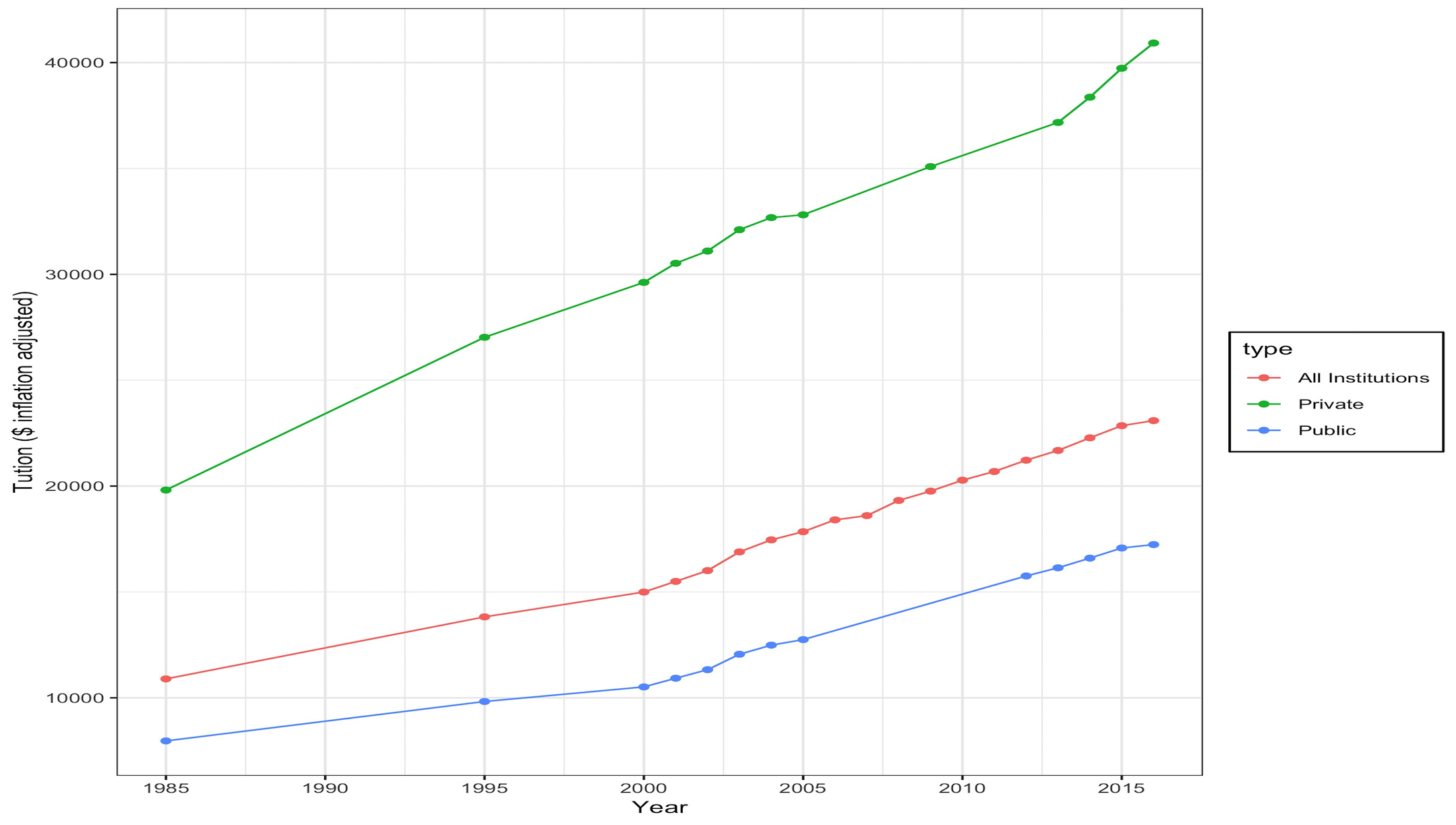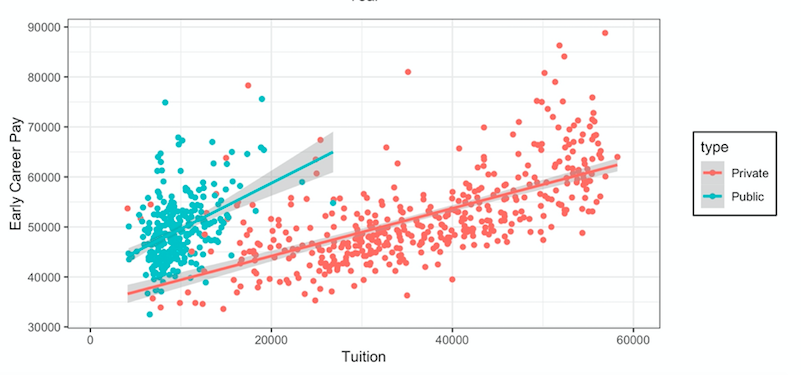College Tuition & Career Earnings
I've recently started to participate in Tidy Tuesday, a weekly social data project in R.
This week, they shared an extremely rich dataset, on college tuition, diversity, and salary.
There is so much more I wanted to do with this data. But because I still have my PhD to finish, I limited myself. At the bottom of my code I commented out some interesting relationships between tuition and diversity that I didn't have time to pursue.
Here are some tweets from people who did pursue these questions:
Really proud of my #TidyTuesday plot! My very first #STACKED bar chart also :)
— Dr. Sara Iacozza (@IacozzaSara) March 12, 2020
Diversity in Private vs Public schools per US States - ranked by tuition costs
Code ⌨️: https://t.co/wYZvcFAhWq pic.twitter.com/Ex3Qa6tecv
New #TidyTuesday - now on US tuition, earning potential and women or minority students. All code here: https://t.co/tktDu94LqQ pic.twitter.com/D0JH5eZgOO
— Dr Eva Murzyn (@EvaMurzyn) March 11, 2020
The question(s)
- We know that tuition has been rising - but is this true when we adjust for inflation? Is this driven by public or private schools?
- What is the relationship between tuition and salary?
The rise of tuition
To answer this, I used the historical_tuition data, which has average college tuition data from 1985. I decided to look at dollar inflation adjusted tuition to aid in interpretability.
historical_tuition %>%
filter(tuition_type == 'All Constant') %>%# dollar inflation adjusted
ggplot(data = ., aes(x = yr, y = tuition_cost, group_by(type), color = type) ) +
geom_point() +
geom_line() +
theme_bw() +
theme(legend.background = NULL) +
xlab('Year') +
ylab('Tution ($ inflation adjusted)') +
scale_x_continuous(breaks = seq(1985, 2015, 5))
 |
Tuition is rising when we adjust for inflation.
It is rising in both Public and Private Institutions
Relationship between tuition and earnings
Next, I plotted the relationship between tuition and average early-career salary.
 |
From the image, there are a few noticeable trends:
- There seems to be a positive relationship between Tuition and Early-career salary.
- The relationship between Tuition and Early-career pay appears stronger for Public Institutions, rather than Private Institutions (in other words, the slope looks steeper). We're a bit limited here, though, since the range of tuition is lower for Public institutions.
- Early career pay looks higher, on average, for Public Institutions.
To test the statistical significance of these effects I used lme4 to build simple linear models in R.
lm.0 = lm(data = dat, early_career_pay ~ 1)
lm.1 = lm(data = dat, early_career_pay ~ 1 + in_state_tuition)
lm.2 = lm(data = dat, early_career_pay ~ 1 + in_state_tuition + public_dummy)
lm.3 = lm(data = dat, early_career_pay ~ 1 + in_state_tuition + public_dummy + public_dummy:in_state_tuition)
summary(lm.3)
Coefficients:
Estimate Std. Error t value Pr(>|t|)
(Intercept) 3.465e+04 9.699e+02 35.728 < 2e-16 ***
in_state_tuition 4.767e-01 2.524e-02 18.889 < 2e-16 ***
public_dummy 5.792e+03 1.643e+03 3.525 0.00045 ***
in_state_tuition:public_dummy 4.384e-01 1.331e-01 3.293 0.00104 **
---
Signif. codes: 0 ‘***’ 0.001 ‘**’ 0.01 ‘*’ 0.05 ‘.’ 0.1 ‘ ’ 1
We can use these Estimates to better interpret this statistical model:
How much more are earnings for graduates when they attend schools with higher tuition?
We know that for every $1 increase in tuition, earnings increase by $0.47 (all else equal). This means, a $5,000 increase in tuition is associated with $2,385 more in yearly earnings.How much more are students at Public institutions earning? . The estimate for
public_dummytells us that on average, Students at Public institutions are earning $5,792 more. However, this is where “all else equal” becomes important. Not many Private schools are in the same tuition-range as Public schools. Students at the Private schools that cost more are out-earning the Public school students.Seeing the forest through the trees.
Our intercept estimate indicates that the average early-career salary is $34,650. With today's average yearly tuition hovering well-above $20k, it really makes you think about the bang for your buck when picking a school.
Feel free to post a comment here, or comment on my original tweet:
SUCH rich data from this week's #tidytuesday on tuition, earning potential, and student diversity. Not surprising: Tuition continues to rise, and is associated with earnings. What surprised me: The relationship b/w pay and tuition is especially true for Public Institutions. pic.twitter.com/0BBaoPyCB5
— Robin Sifre, Ph.D. (@SifreRobin) March 10, 2020